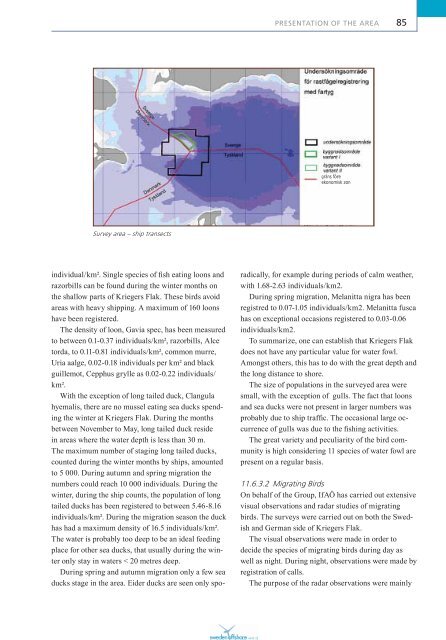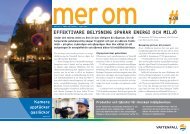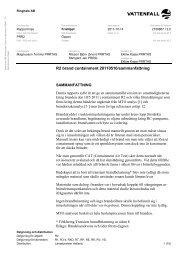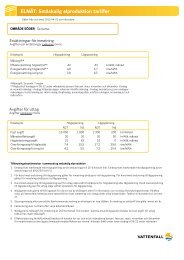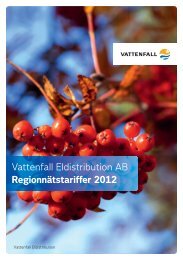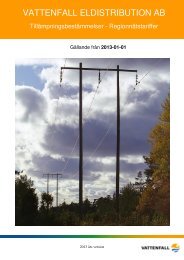This environmental impact assessment for Kriegers flak ... - Vattenfall
This environmental impact assessment for Kriegers flak ... - Vattenfall
This environmental impact assessment for Kriegers flak ... - Vattenfall
You also want an ePaper? Increase the reach of your titles
YUMPU automatically turns print PDFs into web optimized ePapers that Google loves.
Survey area – ship transects<br />
individual/km². Single species of Þ sh eating loons and<br />
razorbills can be found during the winter months on<br />
the shallow parts of <strong>Kriegers</strong> Flak. These birds avoid<br />
areas with heavy shipping. A maximum of 160 loons<br />
have been registered.<br />
The density of loon, Gavia spec, has been measured<br />
to between 0.1-0.37 individuals/km², razorbills, Alce<br />
torda, to 0.11-0.81 individuals/km², common murre,<br />
Uria aalge, 0.02-0.18 individuals per km² and black<br />
guillemot, Cepphus grylle as 0.02-0.22 individuals/<br />
km².<br />
With the exception of long tailed duck, Clangula<br />
hyemalis, there are no mussel eating sea ducks spending<br />
the winter at <strong>Kriegers</strong> Flak. During the months<br />
between November to May, long tailed duck reside<br />
in areas where the water depth is less than 30 m.<br />
The maximum number of staging long tailed ducks,<br />
counted during the winter months by ships, amounted<br />
to 5 000. During autumn and spring migration the<br />
numbers could reach 10 000 individuals. During the<br />
winter, during the ship counts, the population of long<br />
tailed ducks has been registered to between 5.46-8.16<br />
individuals/km². During the migration season the duck<br />
has had a maximum density of 16.5 individuals/km².<br />
The water is probably too deep to be an ideal feeding<br />
place <strong>for</strong> other sea ducks, that usually during the winter<br />
only stay in waters < 20 metres deep.<br />
During spring and autumn migration only a few sea<br />
ducks stage in the area. Eider ducks are seen only spo-<br />
PRESENTATION OF THE AREA 85<br />
gräns före<br />
ekonomisk zon<br />
radically, <strong>for</strong> example during periods of calm weather,<br />
with 1.68-2.63 individuals/km2.<br />
During spring migration, Melanitta nigra has been<br />
registred to 0.07-1.05 individuals/km2. Melanitta fusca<br />
has on exceptional occasions registered to 0.03-0.06<br />
individuals/km2.<br />
To summarize, one can establish that <strong>Kriegers</strong> Flak<br />
does not have any particular value <strong>for</strong> water fowl.<br />
Amongst others, this has to do with the great depth and<br />
the long distance to shore.<br />
The size of populations in the surveyed area were<br />
small, with the exception of gulls. The fact that loons<br />
and sea ducks were not present in larger numbers was<br />
probably due to ship trafÞ c. The occasional large occurrence<br />
of gulls was due to the Þ shing activities.<br />
The great variety and peculiarity of the bird community<br />
is high considering 11 species of water fowl are<br />
present on a regular basis.<br />
11.6.3.2 Migrating Birds<br />
On behalf of the Group, IfAÖ has carried out extensive<br />
visual observations and radar studies of migrating<br />
birds. The surveys were carried out on both the Swedish<br />
and German side of <strong>Kriegers</strong> Flak.<br />
The visual observations were made in order to<br />
decide the species of migrating birds during day as<br />
well as night. During night, observations were made by<br />
registration of calls.<br />
The purpose of the radar observations were mainly


